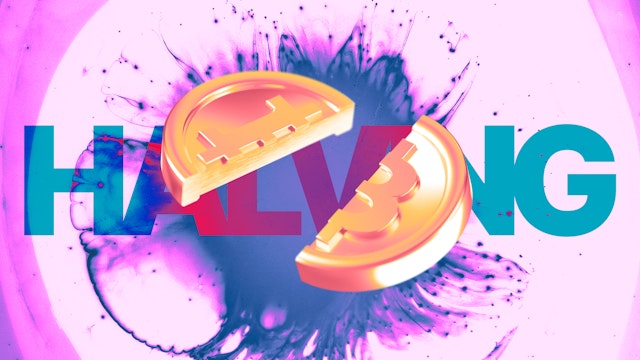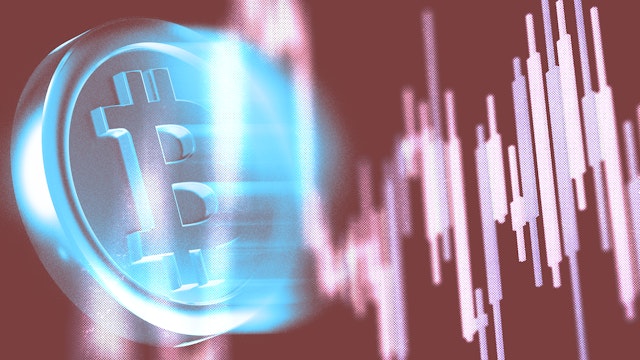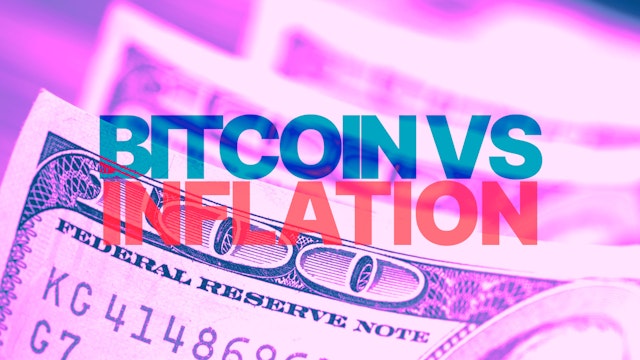The Bitcoin Halving - What Happens to the Price of BTC?
The Bitcoin Halving event happens every four years. But what effect does it have on both the BTC price and on the cryptocurrency itself?
In this article...
- The Halving can have an effect on the price of Bitcoin
- The Halving happens every four years and generally speaking some time afterwards there can be a price rise
- The Halving is designed to create scarcity in the Bitcoin supply

The Bitcoin Halving is the biggest event in cryptocurrency. Occurring once every four years, the Halving – also known as the Halvening – results in a 50% reduction in the amount of new Bitcoin being created.
The creator of Bitcoin, who called themself (or themselves) Satoshi Nakamoto, had an idea to create a deliberately deflationary system. This is where less new money enters the system over time, theoretically resulting in a long-term increase in purchasing power.
This is in contrast to fiat currencies, whose central bank overseers tend to print money in such a way that inflation is kept constant and the currency is worth less over time. (It’s why a Ford Model T cost US$825 in 1909, but an equivalent car might cost closer to US$30,000 now.)
That’s the theory, so what about in practice? So far Bitcoin has experienced three Halvings, with a fourth due on April 20, 2024. Has the experience matched Satoshi's vision?
Halving #1: 28 November, 2012
For the first few years of its life, every Bitcoin block produced 50 new BTC. Worth somewhere close to $5 million dollars in today’s market, the closing price on the day the Halving occurred was US$12 – meaning the block reward went from US$600 to US$300 overnight.
There was a lot of anxiety attached to the first Halving. Bitcoin remained a little-known fringe technology and there were fears that the new economics of the post-Halving market would drive miners out of business and open the network up to attack.
These worries were, obviously, misplaced. Six months later, the price had shot up by around 1000%. By the time the bull market peaked in December 2013, that figure was closer to 10,000%.
Halving #2: 9 July, 2016
The second Halving – where the block reward was reduced from 25 to 12.5 BTC – happened against the backdrop of considerable malaise in the crypto community.
Following the explosive events of 2013, crypto prices had been stuck in a dismal flatline for years. Even worse, Bitcoin was being torn apart by battles over the block size – a conflict that eventually led to the carving off of Bitcoin Cash – and was facing new pressures from the launch of Ethereum. This new network offered the excitement, vision and new functionality that Bitcoin lacked.
Despite this, the market was more optimistic than it had been in years, with prices having already doubled from their mid-2015 nadir.
On Halving day, a single Bitcoin cost US$640. And then for 6 months almost nothing happened. But then the price began surging around December and by March it had reached a new all-time high. Cut to December 2017 and a single Bitcoin was selling for US$20,000 – a 3,000% increase.
Halving #3: 11 May, 2020
If previous Halvings had been accompanied by worries that Bitcoin might collapse, when Halving #3 arrived it felt like the whole world could get there first.
A few months into the worst pandemic in 100 years, the market had already witnessed the worst black swan event in Bitcoin’s history, when the price plunged 50% in a matter of hours after the first global lockdowns were announced in March.
By the time the Halving arrived, most of the damage had been rectified, but to say that it was an uncertain time is putting it lightly. The Bitcoin price was US$8600 on the day of the Halving itself and then spent 6 months doing, once again, not very much.
But come December a new surge saw the price break through the US$20,000 barrier and start rocketing upwards on its way to the US$63,000 mark – a more than 700% increase.
Halving #4: 20 April, 2024
We don’t know what the effect of the fourth Halving is going to be, but already a couple of things set it apart from the previous Halvings.
First is price. Whereas the previous Halvings have all occurred when Bitcoin was around half the price of its previous all-time high, this time we’ve already broken through the US$63,000 mark.
Does that mean any price appreciation should start from this mark? Or does it suggest that the effect of the Halving has already been priced in?
Second is the arrival of the US Bitcoin ETFs. The ETFs are the reason why the Bitcoin price is already so elevated. And by making it considerably easier for institutional investors to access Bitcoin, it’s hoped that their presence will supercharge demand amid newly diminished supply.
Conclusion: Bubbles and the Bitcoin Halving
Looking at the history of the Halving to date, four things become clear:
The long-term trend matches Satoshi’s vision for a currency that appreciates in value over time.
Halving events unleash significant volatility and unstable bubbles.
It can take time for the market to respond after the Halving event.
The percentage gains have become less with each Halving.
So, why do Halvings seem to create bubble effects? Market psychology can be, at times, very simple.
In this case, the Halving produces new interest in Bitcoin, this translates (over time) into a break of the previous all-time high, this produces even more interest in Bitcoin and then everyone races in to try and get a slice of the pie before it’s too late.
However, strip out the bubbles and crashes and you’re left with a chart that goes up and to the right in a fairly predictable fashion – just as Satoshi Nakamoto envisioned.
There’s no guarantee that this formula will continue on into perpetuity. To work, demand for Bitcoin needs to keep on increasing and even with the new ETFs we don’t exactly know what the limit on demand might be.
Similarly, Bitcoin ownership could hit a threshold point (say, a number of countries adding Bitcoin to their balance sheets) that will cause an upwards inflection from the current pattern.
In the end, your best approach is probably to ignore the Halving altogether, keep dollar cost averaging into your investment and stick it out for the long haul. After all, if you’d bought $100 of Bitcoin on the day of the first Halving, you’d have more than $800,000 today.
Frequently asked questions about the Bitcoin Halving
What is Bitcoin Halving?
Bitcoin halving is a programmed event in the Bitcoin protocol that occurs approximately every four years.
During halving, the miner’s reward for creating new blocks is reduced by 50%.
This reduction impacts the rate at which new Bitcoins are introduced into circulation. The halving is a crucial mechanism to control the token supply and maintain scarcity.
How many Bitcoins will ever exist?
The total supply of Bitcoin is capped at 21 million coins. This scarcity is built into the protocol and ensures that no more than this fixed amount will ever be mined.
What triggers the Bitcoin Halving Event?
The halving occurs after every 210,000 blocks are mined. This roughly translates to a four-year interval. As the block reward decreases, miners receive fewer Bitcoins for their efforts.
When will all 21 million Bitcoins be mined?
Estimates suggest that all 21 million Bitcoins will be mined around the year 2140. The gradual reduction in block rewards ensures a controlled release of new coins over time.
How does the Bitcoin network handle transaction fees?
In addition to block rewards, miners earn transaction fees for validating transactions. As the block reward diminishes, transaction fees become more critical for miners’ incentives.
What impact does halving have on Bitcoin’s price?
The halving contributes to Bitcoin’s deflationary nature, making it more akin to precious metals like gold.
Scarcity tends to drive demand, potentially leading to upward pressure on prices. Historical data shows that previous halving events have correlated with price increases.
What role does the Bitcoin blockchain play in halving?
The Bitcoin blockchain records every transaction and maintains the integrity of the network. Halving events are encoded in the blockchain’s rules, ensuring a predictable supply schedule.
How fast are new Bitcoins introduced after halving?
Initially, 50 new Bitcoins were added to the network every 10 minutes. After the first halving, this reduced to 6.25 Bitcoins. The upcoming halving will further decrease it to around 3.125 Bitcoins per block.
Why is the price of Bitcoin closely watched during halving?
Investors closely monitor Bitcoin’s price during halving because it reflects market sentiment. The anticipation of reduced supply often leads to increased demand, potentially impacting prices.

Suggested Articles

The Bitcoin Halving - What is it and When Will it Happen?
The Bitcoin Halving is a big deal in the cryptocurrency world. But what does it mean and when does it happen? We explain the highlight of the crypto calendar.Read more
Why Should You Buy Bitcoin? Top 10 Reasons To Consider
Why should you buy Bitcoin? Here are some compelling reasons why the crypto bros and the crypto sisters think BTC is a great investment.Read more
Why Buying Bitcoin Is a Smart Hedge Against Inflation
Should you buy Bitcoin as a hedge against inflation? What even is a hedge against inflation? Let's find out.Read moreBrowse by topic
Disclaimer: This article is for informational purposes only and does not constitute financial or investment advice. Cryptocurrencies, including Bitcoin, are highly volatile and speculative assets, and there is always a risk that they could become worthless.
Readers should conduct their own research and consult with a qualified financial advisor before making any investment decisions.
CoinJar does not endorse the content of, and cannot guarantee or verify the safety of any third party websites. Visit these websites at your own risk.
Your information is handled in accordance with CoinJar’s Collection Statement.
CoinJar’s digital currency exchange services are operated by CoinJar Australia Pty Ltd ACN 648 570 807, a registered digital currency exchange provider with AUSTRAC.
CoinJar Card is a prepaid Mastercard issued by EML Payment Solutions Limited ABN 30 131 436 532 AFSL 404131 pursuant to license by Mastercard. CoinJar Australia Pty Ltd is an authorised representative of EML Payment Solutions Limited (AR No 1290193). We recommend you consider the Product Disclosure Statement and Target Market Determination before making any decision to acquire the product. Mastercard and the circles design are registered trademarks of Mastercard International Incorporated.
Google Pay is a trademark of Google LLC. Apple Pay is a trademark of Apple Inc.
This site is protected by reCAPTCHA and the Google Privacy Policy and Terms of Service apply.

